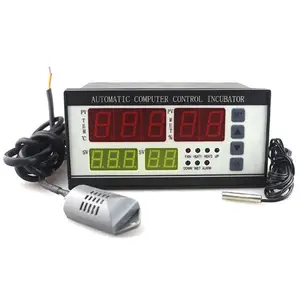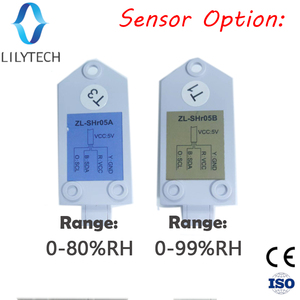
All categories
Featured selections
Trade Assurance
Buyer Central
Help Center
Get the app
Become a supplier

(5224 products available)


























































The egg incubator temperature and humidity controller comes in various types. They include:
DHT11 based Automatic Egg Incubator Temperature and Humidity Controller
The DHT11 controller works with the DHT11 sensor for humidity and temperature. It has an LCD screen that shows the current settings for easy adjustments. The system uses affordable parts, making it cheaper to build. The incubator uses a fan to balance the air, so every egg gets the right heat and moisture. The DHT11 device keeps the interior near the levels of the outside air, which helps in developing living chicks. The system uses a heating source to retain warmth, which must be added by the user.
Egg Incubator Temperature and Humidity Controller with LCD Display
This LCD model is easy to read and set, so users can adjust the incubator with ease. It controls the heat and moisture correctly, which is crucial for keeping eggs alive during incubation. It keeps the inside working like a well-tuned machine, so the setting stays steady even when conditions change outside. The LCD model keeps eggs in the right zone by using sensors to track heat and moisture levels.
Automatic Egg Incubator Temperature and Humidity Controller
This controller system helps keep the right balance of heat and moisture in the incubator. It works without much help, reducing the chance of mistakes. The system uses sensors to track conditions and adjust them as needed. It uses a probe to keep eggs in their ideal range, even when the weather changes outside. It works well for those who need more reliable results during hatching.
Arduino Egg Incubator Temperature and Humidity Controller
The Arduino system comes with a programmable board that gives users full control over the hatching process. It can be changed to fit special needs, making it good for hard-to-hatch eggs. Arduino systems are linked to sensors to keep heat and moisture close to the desired levels. The model can be set up to test and change conditions without help, giving better results. It is great for those who want more control and can program the device.
The egg incubator humidity controller has an extensive commercial value and some of them include:
Precision in Poultry Farming
Egg incubators provide life support in that they create the right settings for living chick eggs. With controllers, the settings stay steady, yielding stronger chicks in mass production farms. This is good since steady results mean higher production levels in commercial farming, boosting farm output.
Reduced Losses
By controlling heat and moisture accurately, controllers help reduce egg loss during incubation. This means that fewer embryos do not hatch, leading to more chicks. This is good news for any hatchery or farm since lost production means lost income, and so fewer operational costs mean higher profits.
Expanded Incubation Capacity
Egg incubators are used a lot in commercial settings, and the added control lets people use big incubators effectively. Large systems maintain even conditions across a big space, allowing more eggs to be incubated at the same time. This builds economies of scale, reducing the cost per egg.
A Growing Market with High Demand
As the global desire for poultry increases, so does the need for good incubators. Automated egg incubation systems bring better heat and moisture control to the market, meeting the demand for reliable incubation solutions. This focus on poultry meets the demand from farmers looking for tech that will raise their yields.
Application in Other Industries
Humidity and temperature controllers for egg incubators work not only in poultry farming but also in other fields like research, reptile breeding, and fish farming. This expands their use and raises the value of the devices, as they are not just limited to one industry.
Here are a few key factors buyers should consider when purchasing egg incubator temperature and humidity controllers:
Automation level
Egg incubators with varying degrees of automation are available to buyers. Some are fully automated and can turn the eggs themselves, while others might require users to do it manually. Fully automated controllers are more convenient and time-saving, while partially automated ones might be more suitable for small-scale farming or projects.
Precision and Range of Sensor
Sensors are the most important parts of these controllers since they are responsible for temperature and humidity measurement. Buyers need to consider purchasing models with DHT sensors that provide accurate readings of both parameters. Additionally, they should ensure the sensors have a wide range for incubation of different egg types.
Heat Source
The controllers work with different heating sources, so buyers need to consider which ones they will work with. Some systems are connected to light bulbs, while others are connected to heaters. Ensuring compatibility with the existing heating systems will allow for easier integration of the controller into the existing incubating system.
Ease of Use and Installation
The usability and installation of the controllers should also be considered. Buyers should select systems that are easy to set up and have interface options for easy operation. Touch screens are easy to work with due to their user-friendly interfaces. HVAC digital thermostats also feature user-friendly interfaces and can be easily used by buyers. Furthermore, they need to ensure the controllers are waterproof and will not get damaged during the process.
Price and Budget
Finally, the main factor to consider is the price of the controller. Each type of controller will have different prices based on its features, so buyers need to select the one that has all the necessary features at a low price. They should avoid purchasing based on price alone and instead focus on getting a product that will effectively meet their needs.
A1. These controllers can work for other types of incubation as long as they are set to the correct temperature and humidity. However, the controllers are primarily designed for poultry and other eggs due to their specific requirements.
A2. Yes, both manual and automatic egg incubators can effectively use these controllers. For manual incubators, the user needs to set the parameters manually, while for automatic incubators, the controllers will maintain the set levels without much user intervention.
A3. These controllers do not require much maintenance, but the sensors should be cleaned and calibrated regularly for effective results. Additionally, users should check other parts for any possible defects if they want the controller to work well.
A4.Humidity and temperature controllers work together and create the right settings for eggs. A humidistat only controls humidity but not temperature. These two work well with each other to keep the right heat and moisture in the incubator.
A5. Yes, these controllers can be used on DIY incubators to make the process more effective. However, the controllers should be set to the right parameters to work effectively on DIY incubators.
In conclusion, an egg incubator hydrometer and other controllers are essential products that buyers need to consider when purchasing. They should select products based on the above factors and ensure they choose the ones that meet the needs of their target market.